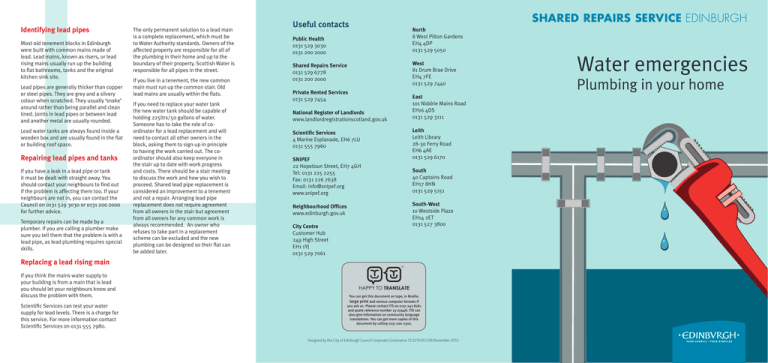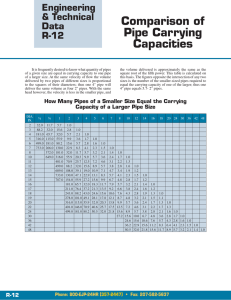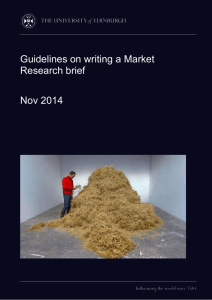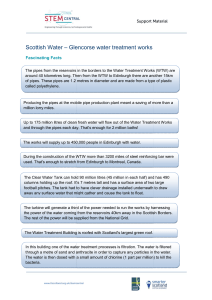now - The City of Edinburgh Council
advertisement

Identifying lead pipes Most old tenement blocks in Edinburgh were built with common mains made of lead. Lead mains, known as risers, or lead rising mains usually run up the building to flat bathrooms, tanks and the original kitchen sink site. Lead pipes are generally thicker than copper or steel pipes. They are grey and a silvery colour when scratched. They usually ‘snake’ around rather than being parallel and clean lined. Joints in lead pipes or between lead and another metal are usually rounded. Lead water tanks are always found inside a wooden box and are usually found in the flat or building roof space. Repairing lead pipes and tanks If you have a leak in a lead pipe or tank it must be dealt with straight away. You should contact your neighbours to find out if the problem is affecting them too. If your neighbours are not in, you can contact the Council on 0131 529 3030 or 0131 200 2000 for further advice. Temporary repairs can be made by a plumber. If you are calling a plumber make sure you tell them that the problem is with a lead pipe, as lead plumbing requires special skills. The only permanent solution to a lead main is a complete replacement, which must be to Water Authority standards. Owners of the affected property are responsible for all of the plumbing in their home and up to the boundary of their property. Scottish Water is responsible for all pipes in the street. If you live in a tenement, the new common main must run up the common stair. Old lead mains are usually within the flats. If you need to replace your water tank the new water tank should be capable of holding 225ltrs/50 gallons of water. Someone has to take the role of coordinator for a lead replacement and will need to contact all other owners in the block, asking them to sign up in principle to having the work carried out. The coordinator should also keep everyone in the stair up to date with work progress and costs. There should be a stair meeting to discuss the work and how you wish to proceed. Shared lead pipe replacement is considered an improvement to a tenement and not a repair. Arranging lead pipe replacement does not require agreement from all owners in the stair but agreement from all owners for any common work is always recommended. An owner who refuses to take part in a replacement scheme can be excluded and the new plumbing can be designed so their flat can be added later. Useful contacts Public Health 0131 529 3030 0131 200 2000 Private Rented Services 0131 529 7454 National Register of Landlords www.landlordregistrationscotland.gov.uk Scientific Services 4 Marine Esplanade, EH6 7LU 0131 555 7960 SNIPEF 22 Hopetoun Street, EH7 4GH Tel: 0131 225 2255 Fax: 0131 226 7638 Email: info@snipef.org www.snipef.org City Centre Customer Hub 249 High Street EH1 1YJ 0131 529 7061 North 8 West Pilton Gardens EH4 4DP 0131 529 5050 West 81 Drum Brae Drive EH4 7FE 0131 529 7440 Shared Repairs Service 0131 529 6778 0131 200 2000 Neighbourhood Offices www.edinburgh.gov.uk SHARED REPAIRS SERVICE EDINBURGH East 101 Niddrie Mains Road EH16 4DS 0131 529 3111 Leith Leith Library 28-30 Ferry Road EH6 4AE 0131 529 6170 South 40 Captains Road EH17 8HN 0131 529 5151 South-West 10 Westside Plaza EH14 2ET 0131 527 3800 Replacing a lead rising main If you think the mains water supply to your building is from a main that is lead you should let your neighbours know and discuss the problem with them. Scientific Services can test your water supply for lead levels. There is a charge for this service. For more information contact Scientific Services on 0131 555 7980. You can get this document on tape, in Braille, large print and various computer formats if you ask us. Please contact ITS on 0131 242 8181 and quote reference number 13-0744H. ITS can also give information on community language translations. You can get more copies of this document by calling 0131 200 2300. Designed by the City of Edinburgh Council Corporate Governance 13.027k/SFC/SR/November 2013 Water emergencies Plumbing in your home SHARED REPAIRS SERVICE EDINBURGH Water emergencies Plumbing in your home This leaflet tells you how to deal with plumbing emergencies. Plumbing problems, such as burst pipes, can cause a lot of damage to your home and properties around you. This leaflet will also help you identify if you have lead pipes and tell you what to do about them. Finding a plumber Try and get recommendations for a plumber before your emergency happens. If you need to get someone from a list, you can look within the members of SNIPEF (Scottish and Northern Ireland Plumbers Employers Federation). How to turn off the water supply Try to turn the water off. Ideally, if you live in a flat, you will have one stop tap outside the front door and one just inside it. You may be used to calling the stop tap a stop cock or control valve. In new build property they are usually found in cupboards. Try to find it before there is an emergency. Show everyone in your house where the stop tap is and how to use it and put a label on it saying what it is. You may find you have a separate stop tap for the mains kitchen tap and the tank supply. In older properties you might not be able to find the stop tap. Check that you can turn the stop tap on and off. Do this 3–4 times each year to make sure it is not stuck. You may also have separate stop valves for pipes leading to washing machines or other appliances. There should also be valves in the pipes leading from the cold water tank. Your plumbing and gas supplies must be earthed for safety. An electrician should be able to check your earth bonding is adequate. What do I do if my pipes burst? Turn off the water as close to the tank as possible - or at the mains stop cock if necessary. Turn off all immersion heaters and hot water heaters if you have cut their water supply. Drain leaking pipes and tanks by turning on the bath and sink taps. Find the leak and consider temporary repairs until you can get a plumber to look at it. Contact your insurer to check what kind of cover you have for water leaks. Although household contents insurance is not compulsory without it this kind of incident could be very costly. Where possible and safe to do so, dry the area well, lift floor boards and floor coverings and take out any insulation between the floor and ceiling below. Dry out any electrics before using them again. Deafening and insulation should be replaced or reinstated before floorboards are put back. DIY stores. Tanks in the loft should also be insulated. The insulation must go right over the lid of the tank. (A lid on a tank is a Scottish water byelaw requirement as it prevents the water becoming contaminated.) However, the roof insulation should not go under the tank - there should be a small gap to allow some of the heat out to stop the tank from freezing. What do I do if my overflow is leaking? Water dripping from a pipe in the wall or under the eaves is probably coming from a toilet or cold water storage tank overflow. If you can safely get access to the tank or cistern, lift the lid and check the condition of the ball valve. When the water in the tank is high enough, the ball float should rise, lifting the arm enough to close a valve and stop more water coming in. If the float has sunk in the water, it might have a leak in it. If this is the case you can rest a piece of wood across the top of the tank to hold the ball out of the water. Make a hole to let out any water and seal a plastic bag over the ball to stop it filling up again. Floats can usually be screwed off the valve arm. Try to leave everything open for as long as you can. If things are drying out too slowly you could rent a dehumidifier. Don’t be tempted to leave things damp as this can encourage dry or wet rot. However, if the ball is floating properly, then check to see if there is an adjustment screw that allows you to set the ball lower and stop the water coming up as high. (2 cm or an inch below the overflow outlet level is about right.) In older systems with a metal arm on the ball valve, you may be able to bend the arm holding the ball. Be careful not to break it. How do I insulate my pipes and tanks? How to deal with a leak from the property above Any supply pipe that goes through an unheated area such as the roof or an outhouse should be insulated. You can buy easy to use lagging products from Try to make sure you have contact details of flats above and below your flat and to give your details to your neighbours for use in an emergency. In the event of a leak contact your neighbour. If they are not in leave a note. If you know the property is a private let you can trace the owner or agent by looking on the National Landlord Register at www.landlordregistrationscotland.gov.uk If the flat above has an individual water stopcock and your neighbour is not in you could turn this off. If the water leak is not containable until your neighbour returns, the Council may be able to force entry to the flat above to stop the leak. Contact 0131 529 3030 or 0131 200 2000 out of office hours for help. What if I find damp patches? Try to find the source of the leak first. It may be coming from leaking gutters, slipped slates, pinhole leaks in a pipe or a broken appliance. Whatever the cause, get it fixed first and then make sure everything is well dried out. Your plasterwork may still be damaged even after the dampness has dried out so seal it before repainting. How do I get access to my neighbours’ house? Use the contact details for your neighbour or ask other neighbours if they have contact numbers for the flat causing the problem. If the property above you is leaking into your property and you cannot get access, call the Council on 0131 529 3030 or 0131 200 2000 out of office hours. What if my pipes are blocked? Most drains and waste pipes have U bends (water traps) fitted. A water trap is used to make sure there is always a section of pipe filled with water, which stops smells coming up from the drains. The trap or drain can become blocked with bits of food or soap residue. Sometimes, using a plunger will deal with the problem. To help stop your pipes becoming blocked try not to let any food go down your sink, regularly check the filter in your washing machine and run your dishwasher whilst empty. Sinks usually have a removable trap under them. If you think your pipe is blocked at the water trap and would like to try and clear the blockage then put the plug in the sink and put a bucket under the trap. Unscrew the trap and clean it out. Flush the whole system through with hot water and washing soda. Do not use chemical pipe cleaners as these can cause damage. Always check the label first. Outdoor drains also have traps and these may need to be cleaned out. You can do this by hand or by using a piece of wire coat hanger or similar. Use good quality rubber gloves to protect your hands. If you think there may be needles or sharp objects in the trap, don’t try to clean the trap yourself. You should always seek professional advice before undertaking any work like this yourself. If unblocking the trap does not work, you may need to access the pipe elsewhere and use rods or a water jet to remove the blockage. Call a plumber or get more advice before you attempt this. What if my outside pipes are blocked? Blocked gutters can lead to water spilling over which soaks walls and causes damp patches. Clean your gutters yearly to prevent this happening. If you have trees nearby, you may need to clean the gutters more than once a year. Fit wire balls or specially manufactured leaf guards at the top of the outlet pipe from the gutter to help prevent blockages occurring. Gutters and downpipes can also split and lead to damp patches. Broken sections of pipe should be replaced, but you may be able to make a temporary repair with a patching solution from your DIY store. Get the correct kind for the type of pipe that you have (plastic, aluminium or iron). If you don’t think it is safe to do yourself, get a professional in. Drainage If you have problems with the drains within your shared property you can contact the Council on 0131 200 2000 (24 hours a day, 7 days a week). We will respond to shared drainage emergencies within two hours. The Shared Repairs Service will clear the blockage but it is up to the owners to get together and deal with more complex drainage work. In an emergency, the Council can also serve a statutory notice on the owner of any drain or pipe for an individual property which is blocked, damaged or leaking and therefore causing a risk to health. If you think any of your drainage presents a health risk contact the Council on 0131 529 3030. When work is carried out by the Council, owners will be billed for an equal share. For drainage problems outwith the curtilage (enclosed space of ground and buildings immediately surrounding a house) of the property you can contact Scottish Water on 0845 601 8855 Recognising and replacing lead pipes in your home Lead water pipes are old, may leak, and are not suitable for drinking water – young children should not drink water from lead pipes. Houses and flats built before 1955 may well have lead pipes unless they have already been replaced.






